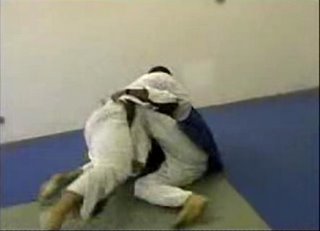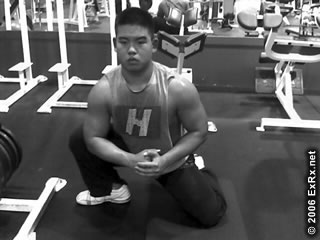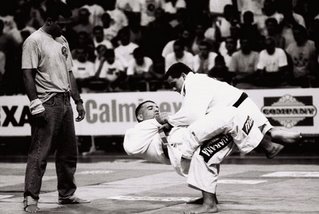Everybody can do it now. So let's do it.
We're gonna tighten up. Let's do the tighten up.
You can do it now. So baby get to it.
Let's do your left now. Let's do your right.
You can do it. But don'tcha just do it light.
Come on and tighten up. Tighten it up now."
With much respect to Archie Bell and the Drells ...

That's what I've got to do. It is ridiculous that I can review almost every roll of the night in my head on the drive home, seeing exactly what I did wrong and where. Maybe it's the sugar (or lack thereof) ... but so often by the time we start sparring the pathways between my brain and my body just break down. Things that will be obvious in about half an hour become completely opaque. I've got a guy in my guard and don't even think to try the Werdum series (judo armlock/pendulum sweep/kimura/crossover sweep). I'm still moving in half-steps from the guard: the arm-wrap but no committed choke attack, hips still virtually nailed to the mat. It's no wonder I've never caught anybody (not submitted, but caught) with an armbar from the guard.
But that's why I've been pulling guard as often as possible lately in sparring. It's not as if my top game is all that great. But I think I've at least got my top game coded. I'm learning some nice details, like underhooking the arms when on top in north/south rather than overhooking them. But I know what I'm trying to do on top--even if I don't do it or do it well.
The clock choke that Mamazinho showed us again tonight is a good example. I think I know what I'm supposed to do fairly well. I threw one at a new guy, a strong white belt, tonight during sparring. I didn't get it, but I was able to at least do the attack.
But from the bottom is another story entirely. The half-guard game is just coming along. I've only been trying to emphasize the Bravo half-guard stuff for the past few weeks, so I want to be patient with that. But I want to bring up the full guard (including Tommy's Spider Guard Triangle and Omoplata, which I've completely abandoned ...) at the same time. I've got the Werdum series. I'm still working the Marcelinho/butterfly guard (which guys are still doing a pretty good job of passing ...)
Six months from now, I want to be submitting people more frequently from the top, and to have my bottom game (half-guard and closed guard) where my top game is now (i.e., competent as an attack, but not consistently effective as a finish). That would be a nice little birthday present to myself.
That is also what gameplans are for. I should work up a Jan-Feb-Mar (Q1) 2007 gameplan and start incorporating it into my training for the last few weeks of 2006. All of this stuff that's been rattling around in my still-reptilian jiu jitsu brain should be plotted out, focused on, worked on consistently every night on the mat.
One thing I will give myself a little credit for is the running escape. I think I got out of three knee on belly attacks just by going for a run. Of course, in typical half-measure fashion, I didn't complete the roll to put myself in guard but instead stayed at knees (which isn't a crime). But given the fact that I found myself in knee on belly (a no-no in and of itself), I'm glad that I was able to incorporate Saulo's running escape so swiftly into my training. We'll see if I can (a) take it into a roll and (b) avoid knee on belly bottom situations in the first place, going forward.
In other news, not as many opportunities to pass guard tonight due to the forementioned guard-pulling, but I didn't do too much impressive on that front when the opportunities were there. Not a single PTMU and the guard pass I think I'll start calling "Big Boy" (since Cesar Gracie explains it as a way to pass the guard from the standing position against a heavy opponent who can't easily be PTMUd) didn't come into play there, either.
Trained with Stephan and Jesse a few times tonight. Always crazy to roll with guys with that kind of ability. I appreciate how they are able to modulate their game--rather than just smashing me for six or seven minutes. It's a certain motivation to try and avoid boring guys like that do death when you're rolling. But if that's one place I can get my de l'audace, encore de l'audace, toujours de l'audace, then I'll take it.













